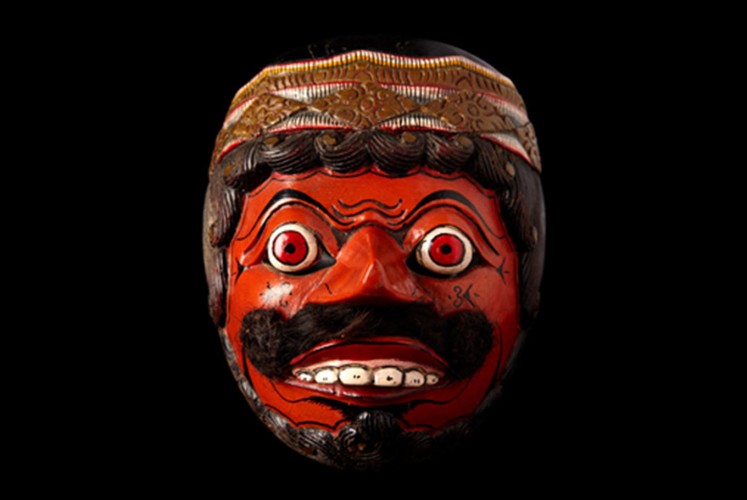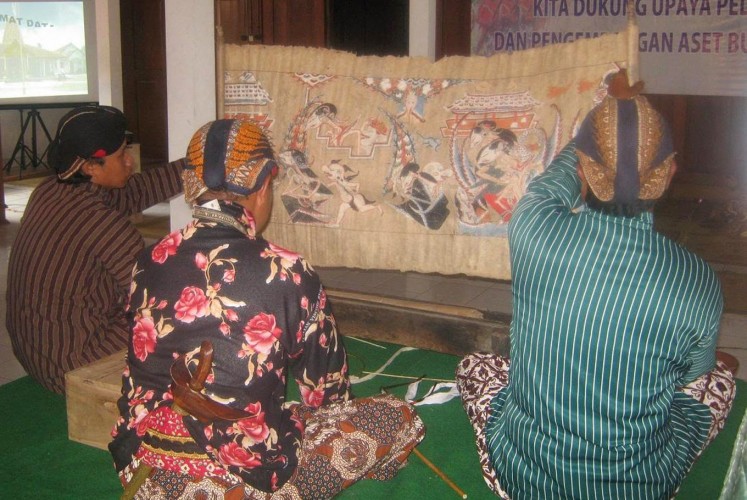Popular Reads
Top Results
Can't find what you're looking for?
View all search resultsPopular Reads
Top Results
Can't find what you're looking for?
View all search resultsReviving Panji tales in arts and culture
Change text size
Gift Premium Articles
to Anyone
M
assively popular for centuries in Java, Bali, Sumatra, and even in other Southeast Asian countries, Panji tales have become the sources of inspiration of other forms of local culture.
Indonesian people have enjoyed Panji tales for generations. Children cherish childhood stories that include the legends of Keong Emas and Ande Ande Lumut, both derived from Panji tales. Yet with the influx of information and foreign culture, Panji tales and other indigenous forms of culture are being pushed further aside and find it hard to compete with modern publishing and communication technologies.
Read also: Great Indonesian literature: Tales of Panji
The influence of Panji tales can be found in dances, theatrical performances, traditional wayang (wayang beber, wayang kelir, wayang krucil) shows and a variety of Panji masks. Panji tales are found engraved on temple reliefs with Panji featured as a character with a distinctive cap on his head.
Here are several local cultures influenced by Panji tales:
Gambuh traditional dance
This traditional dance performance has developed over a significant length of time and has spread widely as a popular folk culture.
In Bali, the Gambuh dance is one of the oldest surviving forms of Balinese performing arts, dating to the time when Majapahit came to Bali circa the 15th-16th centuries. The new royal court introduced a new element of narrative, such as mask dances and Aria operas to Balinese performing arts that have influenced other forms of dance-drama on the island.
Some experts even state that Gambuh drama is the forerunner of contemporary Balinese dance. Formerly dependent on royal patronage, Gambuh is now supported by the local community by presenting performances during temple ceremonies.
Gambuh is a performance that combines dance, music, and acting, with the narration based on Malat, a Balinese version of the Panji tales representing the love story of a Javanese prince, Raden Panji Inu Kertapati, and his lover, Princess Chandra Kirana, that conflicts with the disapproval of the queen. Chandra Kirana who escapes to the woods is chased by Inu Kertapati. The two lovers are reunited following a series of adventures, disguises, and battles. Gambuh is now regularly performed in temple rituals in several villages in Bali.
In 2015, UNESCO included three genres of Balinese traditional dance in the list of Intangible Cultural Heritage (ICH), comprising three wali (sacred dances): Rejang, Sanghyang Dedari and Baris Upacara; three bebali (semi-sacred dances): Topeng Sidakarya, Gambuh and Wayang Wong; and three balhi balihan (entertainment dances): Legong Kraton, Joged Bumbung and Barong Ket Kuntisraya.
Mask
Indonesian topeng (mask) dances predated the Hindu-Buddhist eras. Some native Indonesian tribes still perform traditional mask dances to represent nature or ancestors’ spirits. With the arrival of Hinduism in the archipelago, the Ramayana and Mahabharata epics began to be performed in the local mask dances.
The most popular stories that are represented in the local mask dances are however derived from the locally developed Javanese Panji character, which is based on the tales and romance stories of Prince Panji and Princess Chandra Kirana, set in the 12th-century Kadiri kingdom.
The local masks used in these dances were also developed in the early days of Panji, and combined with the dances create a unique performance. The popular Cirebon mask dance is a development of Panji tales that have been developed with the influence of the typical Cirebon style.
Local mask dances and mask production are actively supported in Malang, East Java. Local dance workshops that are actively reviving and maintain the popularity of mask dances can be found in Malang and Yogyakarta.
Read also: Saving the Javanese heritage of 'Cerita Panji'
‘Wayang Beber’
Being a popular form of folk entertainment, wayang has developed in a unique way into some forms known as wayang beber, wayang kelir or wayang krucil. A famous version wayang beber thrives well in Pacitan and Wonogiri. This typical wayang performance uses a screen or kelir around 1.5 meters long. It is unrolled by the dalang (puppet master), and rolled up each time he has finished telling the episode depicted on the screen. Another screen is unrolled afterward to continue with the following episode.
Read also: Rekindling Malang's Ang Hien Hoo 'wayang orang'
Usually a performance consists of six episodes, each containing four scenes, therefore involving 24 screens in total. A wayang beber artist, Pudjianto, made a screen of 60 meters in length, and the story is presented by gradually unrolling the whole screen.
Ki Slamet Raharjo from Gunung Kidul with a scroll of 'wayang beber' depicting Panji Asmara Bangun. (Danang Agis Arok /File)Wayang beber was once a very popular attraction that used to be performed at weddings or anniversaries. Now it is losing popularity in local communities. The East Java administration is making efforts to revive this traditional art form by appealing to the local people to include wayang beber performances in community events and celebrations, such as weddings, thanksgivings and to encourage the training of new wayang beber performers,
Reviving the Panji arts and culture
The director general of culture in collaboration with the East Java province have drawn up plans to revive the Panji culture, of which the popularity is declining nowadays.
A Panji festival will be organized in July in East Java and in August in Jakarta. The activities will consist of seminars, dances and wayang performances, as well as mask exhibitions.
From July 16, the town of Kediri is staging a week of Panji cultural activities featuring a mass dance performance that will involve more than 1,000 dancers, a number of wayang performances, a mask exhibition and seminars.
On Aug. 3-5, a Panji festival will be staged in Kota Tua, Jakarta, to commemorate the 50th anniversary of ASEAN, that will also comprise Panji dance performances from five provinces, an exhibition and seminars.
In 2018, an international Panji event will be staged in Indonesia that will include dance groups from South Asian countries as participants. (kes)
***
The writer is a former culture and education minister. Since 2016, he has been a member of the National Library team registering old manuscripts of the Panji tales with UNESCO’s registry of the Memory of the World. Currently he is assisting the East Java administration in reviving the Panji culture.
---------------
Interested in writing for thejakartapost.com? We are looking for information and opinions from experts in a variety of fields or others with appropriate writing skills. The content must be original on the following topics: lifestyle ( beauty, fashion, food ), entertainment, science & technology, health, parenting, social media, and sports. Send your piece to community@jakpost.com. Click here for more information.













